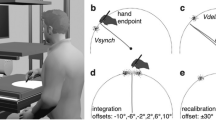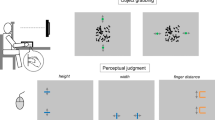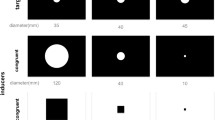Abstract
Actors viewed horizontal segments either in isolation or embedded in patterns that produce spatial illusory effects (Kanizsa's compression illusion and the "dumbbell" version of the Müller-Lyer compression-expansion illusion). They were asked to reproduce the apparent horizontal extent of these segments by the amplitude of open- or closed-loop motor responses (after having positioned a finger on position A, choose a position B on the right of A such that apparent width = B–A). A touchmonitor was used to present the displays and to record movement amplitudes and times. In open-loop motor responses, displays were turned off as soon as actors raised their finger from position A. In closed-loop responses, displays could be viewed continuously during the actions. Four conditions were investigated: (1) open-loop responses starting from A at the right endpoint of the segment; (2) closed-loop responses from A at the right endpoint of the segment; (3) open-loop responses from A at the left endpoint of the segment; and (4) open-loop responses from A aligned horizontally with the left endpoint of the segment but displaced vertically below that segment. With both kinds of display, results in conditions (1) and (2) demonstrated illusory effects comparable to those measured in standard visual matching experiments, whereas results in conditions (3) and (4) showed essentially no illusory effects. Implications for models of visuomotor transformations in peripersonal space are discussed.






Similar content being viewed by others
References
Aglioti S, DeSouza JF, Goodale MA (1995) Size-contrast illusions deceive the eye but not the hand. Curr Biol 5:679–685
Brenner E, Smeets JB (1994) Different frame of reference for position and motion. Naturwissenschaften 81:30–32
Brenner E, Smeets JB (1996) Size illusion influences how we lift but not how we grasp an object. Exp Brain Res 111:473–476
Bridgeman B, Graziano JA (1989) Effect of context and efference copy on visual straight ahead. Vision Res 29:1729–1736
Bridgeman B, Stark L (1991) Ocular proprioception and efference copy in registering visual direction. Vision Res 31:1903–1913
Bridgeman B, Lewis S, Heit G, Nagle M (1979) Relationship between cognitive and motor-oriented systems of visual position perception. J Exp Psychol Hum Percept Perform 5:692–700
Bruno N (2001) When does action resist visual illusions? Trends Cogn Sci 5:385–388
Bruno N, Bernardis P (2002) Dissociating perception and action in Kanizsa's compression illusion. Psychon Bull Rev 9:723–730
Burr DC, Morrone MC, Ross J (2001) Separate visual representation for perception and action revealed by saccadic eye movements. Curr Biol 11:798–802
Carey DP (2000) Eye-hand coordination: hand to eye or eye to hand? Curr Biol 10:R416–R419
Carey DP (2001) Do action systems resist visual illusions? Trends Cogn Sci 5:109–113
Desmurget M, Grafton S (2000) Forward modelling allows feedback control for fast reaching movements. Trends Cogn Sci 4:423–431
Festinger L, Canon LK (1965) Information about spatial location based on knowledge about efference. Psychol Rev 5:373–384
Franz VH (2001) Action does not resist visual illusions. Trends Cogn Sci 5:457–459
Franz VH, Fahle M, Bulthoff HH, Gegenfurtner KR (2000a) Effects of visual illusion on grasping. J Exp Psychol Hum Percept Perform 27:1124–1144
Franz VH, Gegenfurtner KR, Bulthoff HH, Fahle M (2000b) Grasping visual illusions: no evidence for a dissociation between perception and action. Psychol Sci 11:20–25
Gentilucci M, Chieffi S, Daprati E, Saetti MC, Toni I (1996) Visual illusion and action. Neuropsychologia 34:369–376
Gibson JJ (1979) The ecological approach to visual perception. Houghton Mifflin, Boston, MA
Glover SR, Dixon P (2001) Dynamic illusion effects in a reaching task: evidence for separate visual representation in the planning and control of reaching. J Exp Psychol Hum Percept Perform 27:560–572
Goodale MA, Milner AD, Jakobson LS, Carey DP (1991) A neurological dissociation between perceiving objects and grasping them. Nature 349:154–156
Goodale MA, Jakobson LS, Keillor JM (1994) Differences in the visual control of pantomimed and natural grasping movements. Neuropsychologia 32:1159–1178
Haffenden AM, Goodale MA (1998) The effect of pictorial illusion on prehension and perception. J Cogn Neurosci 10:122–136
Hu Y, Goodale MA (2000) Grasping after a delay shifts size-scaling from absolute to relative metrics. J Cogn Neurosci 12:856–868
Jackson SR, Shaw A (2000) The Ponzo illusion affects grip-force but not grip-aperture scaling during prehension movements. J Exp Psychol Hum Percept Perform 26:418–423
Kanizsa G (1975) Amodal completion and phenomenal shrinkage of surfaces in the visual field. Ital J Psychol 2:187–195
Loomis JM, Da Silva JA, Fujita N, Fukushima SS (1992) Visual space perception and visually directed action. J Exp Psychol Hum Percept Perform 18:906–921
Luccio R (1983) Effetti dimensionali del completamento amodale. Ricerche di Psicologia 7:119–136
Milner AD, Goodale MA (1995) The visual brain in action. Oxford University Press, Oxford
Mon-Williams M, Bull R (2000) The Judd illusion: evidence for two visual streams or two experimental conditions? Exp Brain Res 130:273–276
Norman J (2002) Two visual systems and two theories of perception: an attempt to reconcile the constructivist and ecological approaches. Behav Brain Sci (in press)
Pavani F, Boscagli I, Benvenuti F, Rabuffetti M, Farne A (1999) Are perception and action affected differently by the Titchener circles illusion? Exp Brain Res 127:95–101
Post RB, Welch RB (1996) Is there dissociation of perceptual and motor responses to figural illusions? Perception 25:569–581
Trevarthen CB (1968) Two mechanisms of vision in primates. Psychol Forsch 31:299–337
Vezzani S (1999) Shrinkage and expansion by amodal completion: a critical review. Perception 28:935–947
Vishton PM, Rea JG, Cutting JE, Nunez LN (1999) Comparing effects of the horizontal-vertical illusion on grip scaling and judgment: relative vs. absolute, not perception vs. action. J Exp Psychol Hum Percept Perform 25:1659–1672
Westwood DA, Chapman CD, Roy EA (2000) Pantomimed actions may be controlled by the ventral visual stream. Exp Brain Res 130:545–548
Wong E, Mack A (1981) Saccadic programming and perceived location. Acta Psychol 48:123–131
Wraga M, Creem SH, Proffitt DR (2000) Perception-action dissociations of a walkable Müller-Lyer configuration. Psychol Sci 11:239–243
Acknowledgements.
The study was supported by the University of Trieste and its BRAIN Center for Basic Research and Integrative Neuroscience. We are grateful to Susanna Cargnel for her suggestions and help in running some of the studies, and to two anonymous referees for constructive comments on earlier versions of the paper.
Author information
Authors and Affiliations
Corresponding author
Rights and permissions
About this article
Cite this article
Bruno, N., Bernardis, P. When does action resist visual illusions? Effector position modulates illusory influences on motor responses. Exp Brain Res 151, 225–237 (2003). https://doi.org/10.1007/s00221-003-1440-6
Received:
Accepted:
Published:
Issue Date:
DOI: https://doi.org/10.1007/s00221-003-1440-6




